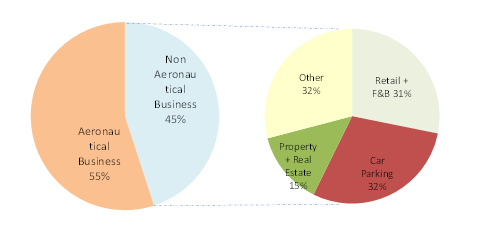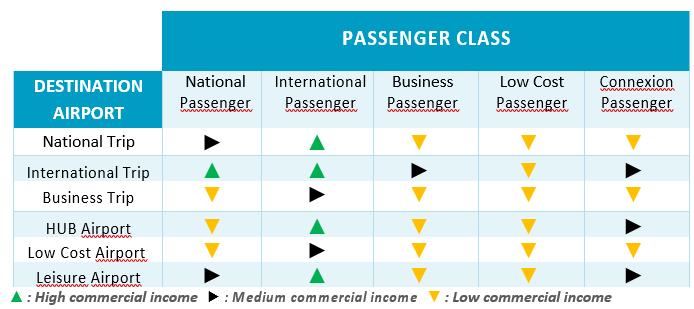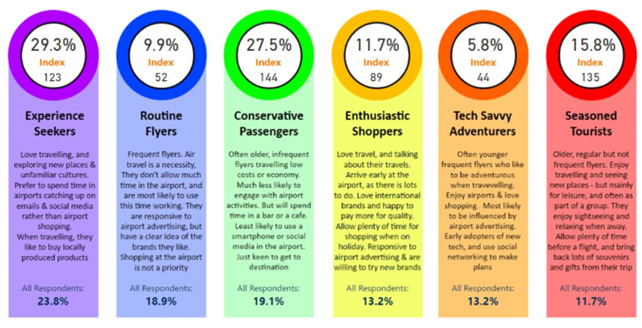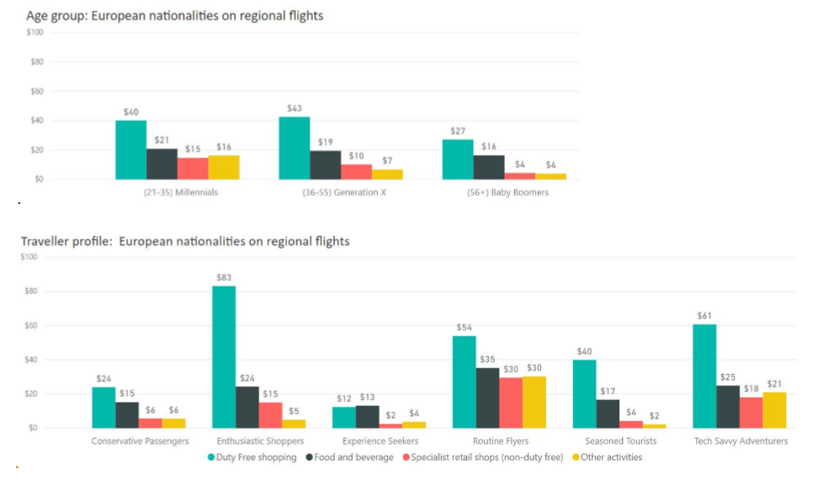The Role of airport retail
Retail management is gaining a growing role moving aggressive airports toward a non-aeronautical business to overcome aeronautical revenues. Next picture shows the distribution of revenues in a typical regional airport.
In order to increase non-aeronautical business, retail must play a more important role through following main driving concepts :
- Apply a strong methodology to analyse the market and the customer profiling
- Pay attention on commercial layout
- Exploit the power of technology to improve the relationships among passengers and retail features
Passenger Profile
The importance of gaining an in‐depth knowledge of the various segments of an airport’s customer base— in terms of demographics, wants, needs, and preferences—to be able to develop a concession programme that will perform well cannot be doubted. A good knowledge of profiles helps in defining better products to sell. By carefully determining which type of buyer will make use of the airport facilities, an ad‐hoc commercial plan can be compiled to make commercial processes more efficient and also increase the non‐aeronautical revenues of the airport. In order to determine the profile of the client, a market study must be performed and the following questions must be answered: Who is the potential buyer? When is it? Why buy? Where is it? How long is it? What do they buy?
This study, to be applied on a periodical base, should have to embrace the following groups of customers : Passengers, Meeters & Greeters at departures and arrivals, airport workers. Other profiling characterstics can depend on the airport profile such as :
- Frequency and seasonality. Average commercial income depends on the type of passenger, (tourism, business, etc.), but can also be influenced by seasonality. Each type of airport has a different distribution. Some may have their highest income in a specific period of the year, whilst in other airports passengers will spend more uniformly throughout the year. Measurement of the different types of passengers will facilitate defining the mix of products offered at the airport according to the season of the year, and in the different commercial areas of the airport (national or international, airside, landside, etc.)
- Destination: national or international. The destination may condition the commercial mix of the airport. Since it will be conditioning also expenses incurred by a domestic passenger in comparison with an international passenger.
- Direct flight or connecting flight. The type of predominant flights in the airport, or in a terminal or area, can also condition passenger profile and especially available time. The commercial plan of the airport must take into account what types of flights operate to offer the best commercial product depending on their nature: direct or connecting.
- Type of airline: (low cost, flag carrier, charter). Differences between each type of passenger from each airline can determine the type of products that should be marketed or even the type of store, layout and design.
The following table shows the importance of correctly defining the type of passenger, which determines together with the destination airport the spending profile and therefore its influence on commercial revenues.

Moreover, together with a propensity of spending money based on destination airport and passenger class, there is another important view that has to be taken into account to identify the passenger profile of a specific airport. CiR Global Traveller has conducted a Segmentation Study in 2017 (Total respondents: 22,741 from 25 nationalities) retrieving 6 passenger profiles for regional airports in terms of attitude to use technologies, amount of time spent in airport, frequence of travelling, propensity to spending.

Next pictures, based on figures coming from CiR Global Traveller Segmentation Study 2017, show both average amount of purchasing by age class and travelling profiles. Even the preferred retailer classes are pointed out.

Another interesting result of the CiR Global Traveller Segmentation Study is the shopper profiles presenting Buyers, Non Buyers and Non Visitors percentages and the conversion of Visitors in Buyers.

Airport Layout
The design of an adequate layout is the best tool to complement the passenger travel experience.
A properly designed commercial area must be integrated within the whole airport process. Passenger needs for each phase of the trip must be taken into account, from the arrival to the check‐in area and boarding gate, offering retail shops, relaxation services, gastronomy and other services
Looking at the commercial layout several things have to be taken into account to improve commercial performances :
- Avoid commercial spilt between domestic and international flows,
- Adopt a “Walk‐through” shops as a strategy being a more direct way of offering products to the traveller. Walk‐through shops encourage the maximum number of passengers to buy something.
- Clustering of shops allows efficient shopping time. Where possible, it is necessary to create a retail area like a compact mall. This concentrated location generates a critical mass that foresees passengers passing quickly through the retail zone and increasing sales.
- improve the perception of choice among passengers. It is important to diversify the mix of brands available to appeal to a larger portion of passengers.
- Use F&B and other facilities as commercial anchors
- Take the Passenger flow analysis as a base reference to identify locations. In airports, as in any commercial centre, passenger flows are decisive in the profitability of the commercial offer. Knowing the flows and how they affect commercial business are a key factor in Layout design. As a general rule in the design of the Layout, the commercial offer must be located along the natural passenger flow.
- Manage Security control : it is needed to shorten the security control time and place most of the commercial area is on the airside,
Technologies
Technologies should be adopted to stimulate passenger to purchase and monitor sales :
- Sales Control. The airport must know the relevant commercial business information (sales mainly) by means of not intrusive systems in order to :
- Commercial promotion systems. New technologies that offer promotions and information about the airport such as: dynamic screens, interactive maps, mobile applications, beaconing, …
- Loyalty Programmes. A loyalty programme is a marketing strategy that aims to reward the purchases of its customers, which produces in them a sense of loyalty to the brand. This type of programmes offers access to store credits, discounts, prizes or any other type of benefit offered by the brand.
- eCommerce tools to sell any kind of product online both using the airport portal and mobile tools.
- Establishing the correct basis for calculating the Variable Fee when it is applied.
- Ensuring that a detailed database is available for carrying out commercial studies with the main objective of adapting the offer to the clients’ needs.
Stakeholders addressed
Retail management is an ecosystem where airport authorities and retails have to work together.
The Authority must govern retail strategies and retailers have to accomplish the needs to better exploit airport potentials.
Retail management systems require the involvement of all stakeholders to monitor and decide layout and offering changes.
Market Trends
Being the non-aeronautical business more and more relevant for any size of airport, there is a strong focus on the adoption of technological tools to comply with :
- Sales management : acquiring of sales data by means of shop infrastructure and devices and check between data monitored and data provided by retailers
- Sales Analysis : all captured data are stored in a datawarehouse to apply integrated analysis and verify shops profitability, penetration levels, margins, etc.
- Commercial promotion through beaconing infrastructure
- Paxflow monitoring through wifi technologies.
Software Design Solutions
Software Design believes that to increase retail profitability it is necessary to lay on a customer-centric vision and innovative tools together with a good airport commercial layout. This fantastic mix can offer in a dynamic, adaptive, proactive and holistic approach everything that passengers need when they need it.
The approach to the new airport model called “Customer Oriented Airport” is based on the synergistic effect of two essential elements that can transform passengers into airport customers:
- Passenger Experience Improvement
- Non-aviation business growth through loyalty processes. A positive travel experience correlates to higher spending rates and increased revenues.
To implement this new relationship model, Software Design has designed an integrated platform composed of various types of systems that operate together through Business Orchestration functions designed to maximize the benefits of each individual element in a virtuous circle of advantages for the airport and for each user.
Software Design solutions include both field systems and Business modules and have been inspired by a strongly mobile approach.
The platform includes the following solutions dedicated to the retail management :
- ShopView : Sales management system based on not intrusive devices to be installed within shops. Suchdevices capture selling data and send it to the central system where all analysis and checks can be done.
- FlyCommerce : an online system allowing the selling of parking, ancillary services and third party products. The system is open to interface directly external management systems. Payments are applied through payment gateways,.
- Proximity Marketing : Airport services that can be promoted using a generic proximity notifier environment. The proximity notifier has been implemented as a truly generic tool in which it is possible to configure any type of notification by associating it with one or more fences. Fences can be qualifies as beacon or GPS and they can be placed within or outside the airport. The tool is mainly used to promote retailers by linking promotion pages to push notifications envoyed when a passenger enters in a fence.
- Revenue Analysis : Business Intelligence platform dedicated to revenue management.
Well fitted Airport technologies streamline the passenger experience, making airport a place where people want to spend their time and money




